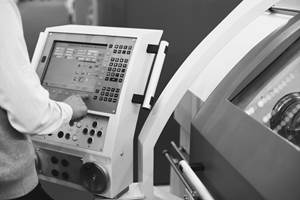Do's And Don'ts For Keeping Dial Indicators In The Game
Just because dial indicators have been around since the early 1900s, don't expect them to fade away with the last century. This tool's long-term popularity is well earned.
Share




Takumi USA
Featured Content
View More





Autodesk, Inc.
Featured Content
View More.png;maxWidth=45)
DMG MORI - Cincinnati
Featured Content
View MoreJust because dial indicators have been around since the early 1900s, don't expect them to fade away with the last century. This tool's long-term popularity is well earned. Dial indicators offer good resolution at low cost, but that is not the main reason people still use them.
Beyond providing easy-to-read quantitative measurement, dial indicators give users a comparative sense that their parts are in the ballpark. The user simply notes if the indicator's needle is within tolerance bands or, simpler still, if the needle lies within red sections highlighted on the dial. No interpreting is necessary.
Dial indicators vary widely in type, size and range. All translate variations (through internal movement of a plunger) into dial readings. Some will indicate dimensional variations as small as 0.00005", so you must handle these sensitive mechanisms with the same devoted care you use with other precision equipment.
To maintain high levels of quality and precision, take heed of the following tips.
DO:
- mount dial indicators close to short support columns on test sets or comparators to avoid holding rod deflection.
- keep the reference surface clean and level, with the test set base clean and seated positively.
- mount your indicator securely to the fixture or holding device.
- keep the indicator spindle and point clean, using a soft, lint-free cloth.
- make sure the indicator hand moves toward the minus side of the dial as workpiece dimension decreases.
- handle the gage lightly, so it can seat itself on the workpiece.
- use diamond, tungsten carbide or hard chromium-tipped indicator points whenever it's likely that the contacts will be subject to heavy wear.
- store dial indicators in a safe, dry place, and cover them to keep the dust and moisture out.
- test indicators under gaging conditions at intervals during the operating day. You can gage a part twice, then compare its readings to a master part.
- clean dials with soap and water, benzene or soft eraser. Frequency of cleaning depends on the type of gaging and the contaminants.
DO NOT:
- subject indicators to harsh, sudden blows. If blows are unavoidable, use a cushioned movement indicator.
- overlook accessories that will make your indicator more efficient, more adaptable and more versatile, such as lifting levers and right angle attachments.
- oil the spindle bearings except under special conditions. Then do it sparingly and never use grease.
- tighten contact points or adapters too far against the rack spindle, as the strain will cause distortion and make the spindle bind and the mechanism stick.
- clamp the indicator against the stem with a set screw. Too much pressure will make the rack spindle bind.
- lock the indicator in position until you've set it carefully under proper gaging tension, that is, at least a quarter turn from its “at rest” position.
- oil an indicator that has been idle for some time. If the spindle sticks, work it in and out by hand until it slides freely on its own bearings.
- drill holes in the back of the case. Chips will get inside and ruin the movement.
- use an indicator that has been dropped or struck until you have it tested thoroughly.
- use your dial indicator for anything but what it is intended for—accurate gaging. It's not a jackhammer or paperweight.
Related Content
The Many Ways of Measuring Thickness
While it may seem to be a straightforward check, there are many approaches to measuring thickness that are determined by the requirements of the part.
Read MoreParts and Programs: Setup for Success
Tips for program and work setups that can simplify adjustments and troubleshooting.
Read MoreTurning Fixed-Body Plug Gages Inside Out
Fixed-body mechanical plug gages provide fast, high-performance measurement for tight-tolerance holes.
Read MoreHelp Operators Understand Sizing Adjustments
Even when CNCs are equipped with automatic post-process gaging systems, there are always a few important adjustments that must be done manually. Don’t take operators understanding these adjustments for granted.
Read MoreRead Next
Registration Now Open for the Precision Machining Technology Show (PMTS) 2025
The precision machining industry’s premier event returns to Cleveland, OH, April 1-3.
Read MoreSetting Up the Building Blocks for a Digital Factory
Woodward Inc. spent over a year developing an API to connect machines to its digital factory. Caron Engineering’s MiConnect has cut most of this process while also granting the shop greater access to machine information.
Read More5 Rules of Thumb for Buying CNC Machine Tools
Use these tips to carefully plan your machine tool purchases and to avoid regretting your decision later.
Read More































.jpg;maxWidth=300;quality=90)











.jpg;maxWidth=970;quality=90)